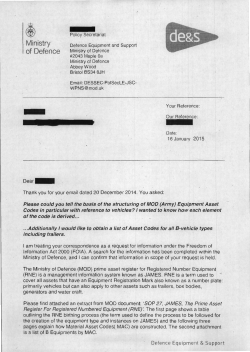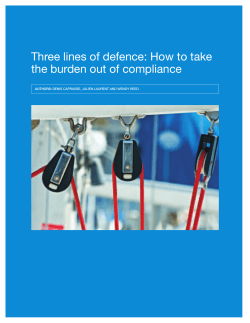
ARMSCOR DOCKYARD
AN ANALYSIS OF ARMSCOR 2013/14 ANNUAL REPORT 15 October 2014 Calvin Manganyi Researcher, Portfolio Committee on Defence and Military Veterans 1 SCOPE • New Board of Directors. • Acquisitions. • Defence Industrial Participation. • Armscor Dockyard. • HR Management and Transformation. • Performance Overview: Under achievements and Challenges. • Financial Statements and Report of the AGSA. 2 NEW BOARD OF DIRECTORS (P. 1) • With effect from 1 May 2014, Armscor has a new Board of Directors. The board membership include: Vice Admiral (ret) R.J. Mudimu, Chairperson, Ambassador T. Skweyiya, Mr M.B.F. Mobu, Dr. M. Khanyile, Adv. VL de la Hunt, Mr R.M. Vokwana, Adv. S. Baloyi, Mr N.M. Tyibilika, Mr. J.S. Mkhwanazi, Acting Chief Executive Officer (CEO); and Mr. J.G. Grobler, Chief Financial Officer. • The Board is assisted by the Executive Management Team including Mr Griesel, Acting General Manager for Acquisition; Mr. T.C. Raman, General Manager for Research and Development; Mr. T.T. Goduka, General Manager for Dockyard; Ms. R.H. Ramgolam, Acting General Manager for Quality; Adv. C.V.V. Ramphele, General Manager for Corporate Compliance; Mr. S. Mbada, General Manager for Human Resources; Mr L. Keyise, Chief Information Officer; and Ms. J.L. Mzili, General Manager for Marketing and Business Development. • NB: Appointment of Chairperson may aid in addressing problems in the Dockyard. 3 ACQUISITIONS (P. 1-3) • Contracts relating to capital equipment acquisition: R4.776 billion. • 18.6 % decrease compared to R5.869 billion for 2012/13. • Armscor has been successful in terms of acquisition of several maritime, airborne, landward and common weapon systems, as well as research and development programmes. • Challenges noted: o Class 209 Mod 1400 Submarines. o Agusta helicopter upgrades. o Lead-In Fighter Trainer Aircraft o A-Darter Missile and Recognition pod. o The Ground-based Air Defence System. o Delays in the Tactical Communications Systems. o Defence Industrial Participation. 4 ACQUISITIONS Questions o Has the submarine escape training facility been completed before the end of July as per the Annual Report? If not, what are the reasons for the delay? o How far is the delivery of the maintenance capability for Lead-In Fighter Trainer Aircraft? o What progress has been made on phase two of the Ground-based Air Defence System? o How far is the progress on the New Generation Tactical Communication System? Will the first few systems be produced in 2014/15 as stated in the Annual Report? o How far is MBDA from discharging its obligations and delivering the missiles? 5 DEFENCE INDUSTRIAL PARTICIPATION (P. 3-4) • No new DIP agreements were entered into in 2013/14. • One DIP agreement, with MBDA (A European based missile developer and manufacturer), related to the SDP remains under the management of Armscor. • For 2013/14, the outstanding obligation remained at R933 million. • The MBDA DIP has been on ongoing concern in recent years. Remark and Question The Committee should enquire a comprehensive explanation of the MBDA DIP agreement and reasons for the fact that obligations are not met. What steps will be taken to remedy the situation? 6 ARMSCOR DOCKYARD (P. 5-6) • 2013/14 financial year was marred by a lack of funding, insufficient capacity and capabilities for the Dockyard. • Dockyard needs a major transformation programme, hence a study was conducted. • Challenges led to the Dockyard not achieving the set target of 90 per cent. Instead it achieved 75.5 per cent against the set target. • Projects experiencing challenges: Frigates and Submarines. 7 ARMSCOR DOCKYARD (Cont.) Questions o What is being done to address problems related to the funding model and to ensure an effective Dockyard? o In terms of the study, what are the (a) main findings, (b) plans to address the problems, and (c) timeline for addressing the challenges observed? o What measures have been put in place to address the Human Resources challenges in the short-term? o What was the impact of delays/incapacity on the side of the Dockyard on the SA Navy’s ability to partake in Operation COPPER, naval exercises or other naval operations? (Note that the DOD’s Maritime programme only achieved 11,080 of 22,000 planned sea hours) o Have all the challenges regarding the frigates and submarine problems undertaken in 2013/14 been addressed? 8 HR MANAGEMENT AND TRANSFORMATION (P. 6-8) • Staff complement: 1 425 (increased by 84 from 1 341 for 2012/13). • Gender: 66.67 % Male (slight decrease from 68.35 % in 2012/13). • Racial Composition: African (39.92 %), White (32.35 %), Coloured (24.35 %), and Indian (3.80 %). • Most significant shifts: 4.13 % increase in African employees; and 3.82 % decrease in White employees. • Addressing Skills shortage: Group of engineers sent abroad for training in various fields; 48 Artisans for training; 36 SA Navy students for practical training; and 23 candidates for Talent Development Programme. 9 HR MANAGEMENT AND TRANSFORMATION (Cont.) Points of clarity o Armscor staff per age group. o Amount allocated for international training of personnel, Number of people making use of this opportunity, Number of people who successfully completed the programmes. o Duration of practical training for SA Navy students in the Dockyard, and how they will contribute in addressing the medium-term concerns related to the Dockyard. o Detailed explanation on the Talent Development Programme. Information should include payment for all studies, contract obligations after completing their studies and, the percentage of students leaving Armscor prior to the termination of their contracts. o Reasons for decreasing the number of candidates to 23 instead of 34 as reported in 2012/13. 10 PERFORMANCE OVERVIEW: UNDER ACHIEVEMENTS AND CHALLENGES (P. 8-12) KPI Goal Achieved • 29 of the KPIs have been achieved. Project status reporting: Dockyard 90% 75.4% •Review 13 ofofABthe KPIs (31 per cent) have not been achieved Logistics Travel 31 August 2013 30 Sept 2013 Finalise three-year SLA with Secdef 31 July 2013 15 Oct 2013 • Identification of opportunities to exploit military technologies and IP 30 June 2013 30 Oct 2013 Employee satisfaction measurement 70% 64,54% Skills development contribution to BBBEE scorecard: 70% 44,1% Renew Storage Area Network 30 June 2013 17 Nov 2013 Replace end of life processing area network 30 June 2013 18 April 2014 ERP: Finalise implementation partner 31 March 2014 In process Develop a Disaster Recovery Plan for the organisation 31 March 2014 15 May 2014 BBBEE policy – transformation and preference for local industry. 30 June 2013 14 Aug 2013 Develop an integrated industry support strategy. 31 Aug 2013 5 March 2014 External client satisfaction survey. 98% 81,3% 11 PERFORMANCE OVERVIEW: UNDER ACHIEVEMENTS AND CHALLENGES (Cont.) Questions • The Key Performance Indicator (KPI) for Project Status reporting: Dockyard to ensure adherence to project contractual milestones as per project plan, was not achieved. What caused these delays, and what measures are in place to prevent the reoccurrence of such delays? • The KPI for Review of AB Logistics Travel, Review all business options and implement was also not achieved in 2012/13. What are the reasons for not achieving the KPI on 31 August 2013 as per goal? • The KPI for three-year Service Level Agreement (SLA) with the Secretary for Defence not achieved and the reason indicated is that final agreement could not be reached on the proposed funding model. What is the solution for this challenge, and what is the time-line for the completion of this agreement? 12 PERFORMANCE OVERVIEW: UNDER ACHIEVEMENTS AND CHALLENGES (Cont.) • The KPI for Employee satisfaction measurement was not achieved. In actual fact, it is a regress from the previous year achievement of 66.48 per cent. What are the reasons for the under achievement? • The KPI for BBBEE policy – transformation and preference for local industry was not achieved. The same goal was also not achieved in 2012/13. How far is the process on the policy? • What measures are in place to ensure that the KPIs indicated as partially achieved are achieved for 2014/15, and beyond? And why are some KPIs indicated as achieved later than planned instead of not achieved as in the case at the end of the financial year? 13 FINANCIAL STATEMENTS AND REPORT OF THE AUDITORGENERAL Financial statements: • Group net value increased from R1.804 billion in 2012/13 to R1.908 billion. • Group’s total comprehensive income decreased significantly from R1.193 billion in 2012/13, to R103.3 million in 2013/14 (R1.08 billion for property revaluation contributed to 2012/13 profit). • Profit for 2013/14 was influenced by the inclusion of the results of the Armscor Medical Benefit Fund which, if excluded, the net result is R76.9 million. • Increase in expenditure on employees’ salaries, wages and other benefits to R836.8 million. • Other Financial Matters: Fruitless and wasteful expenditure (R393 892), Decrease in Armscor Revenue (from R9.2 million in 2012/13 to R6.8 million in 2013/14), and Irregular expenditure (R68.5 million) related to a 25 per cent Black equity selection criterion as requirement. 14 FINANCIAL STATEMENTS AND REPORT OF THE AUDITORGENERAL (Cont.) Financial statements: • • • • Questions The filling of vacancies has been an ongoing concern in recent years. In order to avoid underspending, why is the budget for personnel costs not aligned to a realistic figure for the filling of vacant posts? What are the reasons for the decrease in revenue by the Armscor Dockyard? What were the reasons for late deliveries (fruitless and wasteful expenditure) resulting in penalties of R393 455? Will Armscor still apply its 25 per cent Black equity selection criterion without the exemption from National Treasury? 15 FINANCIAL STATEMENTS AND REPORT OF THE AUDITORGENERAL (Cont.) Report of the AGSA: • Unqualified audit opinion. • Concerns by AGSA: o Expenditure Management: Lack of effective steps to prevent irregular expenditure. o Annual Financial Statement: Submitted statements not prepared in accordance with sections of the PFMA and the Companies Act. • Leadership: Inadequate oversight wrt compliance and related internal controls; Policies and procedures were not, in all respects, aligned with applicable legislation. Questions • Are measures in place to prevent irregular expenditure? • Are there adequate oversight measures to ensure compliance with applicable legislation? 16 •Thank you •~ •Questions Calvin Manganyi Researcher: PC on Defence and Military Veterans cmanganyi@parliament.gov.za 021 403 8100 17
© Copyright 2025








![] How to…Implement BI for PM, targeting Johannes Lombard LSI Consulting](http://cdn1.abcdocz.com/store/data/000199378_1-9bf6d7f7998302cfc97d637ac8a15608-250x500.png)


